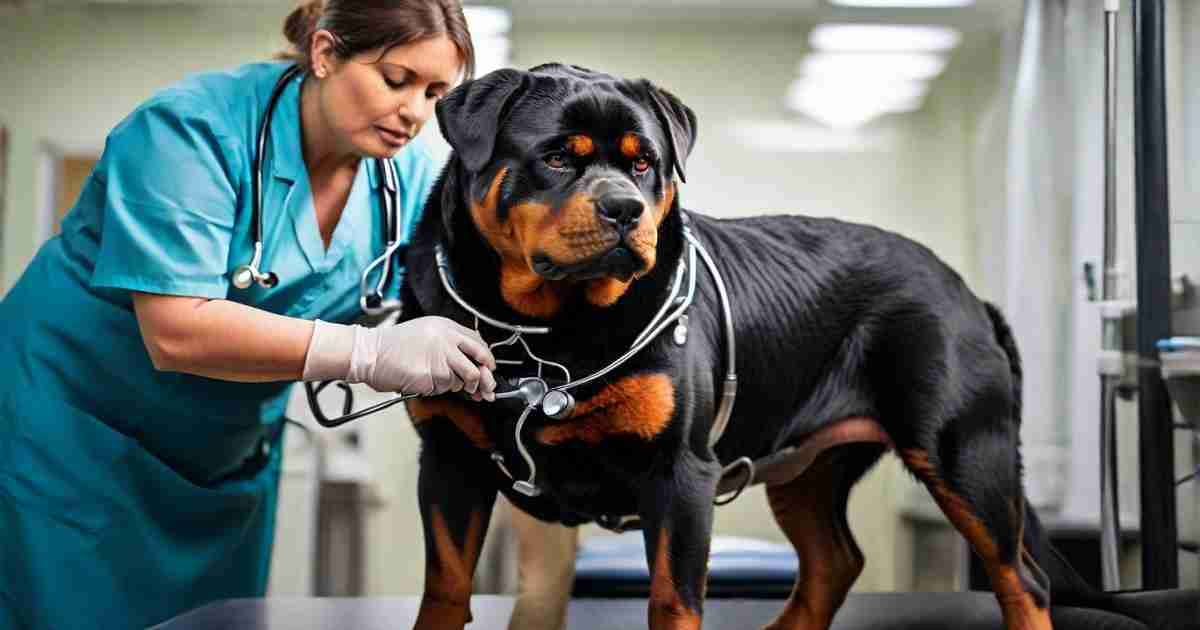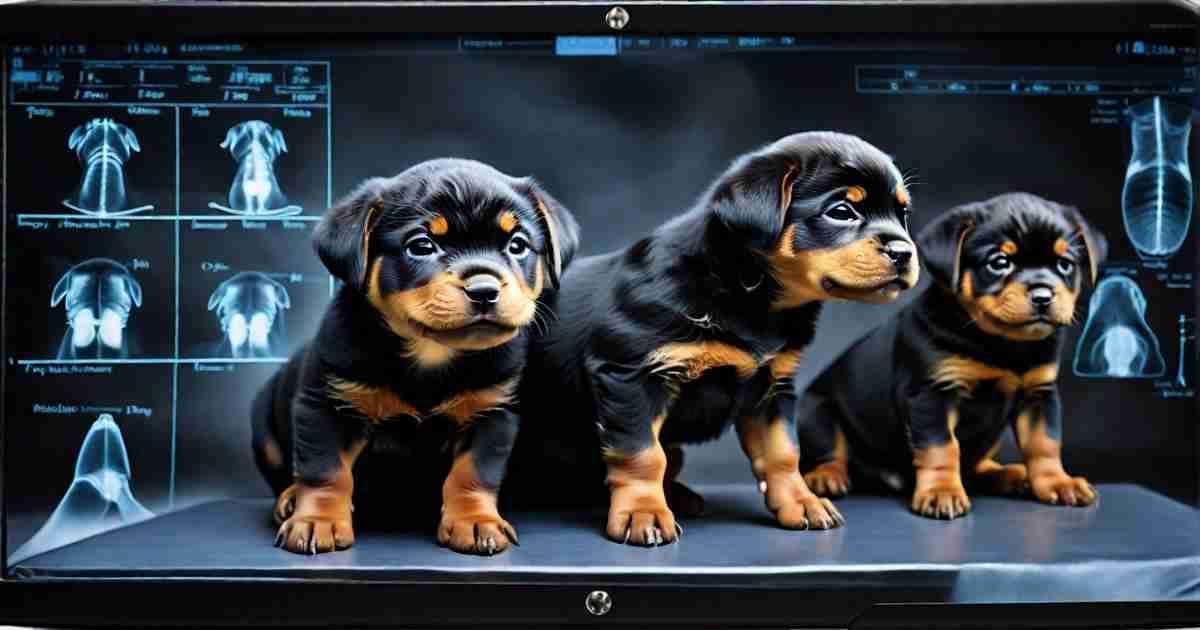Have you been waiting with bated breath to find out if your female Rottweiler is pregnant? As an expectant Rottweiler owner, the suspense must be driving you barking mad!
But no need to be howling in frustration – this comprehensive guide will help you spot the signs of pregnancy in your pooch.
We’ll go over everything from early symptoms like appetite changes and nipple growth, to late-stage signs like nesting behavior and visible belly growth.
You’ll be armed with the knowledge to confidently determine if your Rotty is expecting puppies or if it’s just a false alarm. So settle in, perk those ears up, and let’s get started!
Understanding Rottweiler Reproduction
Rottweiler Reproductive Cycle
- Female Rottweilers go through regular estrous (heat) cycles approximately every 6 months once reaching sexual maturity at around 1.5 years old.
- Each heat cycle has 4 stages: proestrus, estrus, diestrus, and anestrus. Pregnancy can only occur during the estrus stage.
- The fertile window is about 8-11 days long. Ovulation occurs mid-cycle when the female is most receptive to breeding.
- Monitoring your Rottweiler’s cycles can help predict when she may become pregnant.
Factors Affecting Rottweiler Pregnancy
- Age and health impact fertility. Rottweilers in peak physical condition between 2-8 years old have the best breeding potential.
- The timing of breeding is crucial. Breeding too early or late in the heat cycle will lower the chances of pregnancy.
- The quantity and quality of sperm also affect the likelihood of successful fertilization.
- Issues like reproductive disorders may cause infertility in female Rottweilers.
Preparing for Rottweiler Pregnancy
Health Check-Up for Your Rottweiler
- Schedule a comprehensive pre-breeding exam with your veterinarian 4-6 weeks before you intend to start breeding. This full health workup will check for any medical conditions that could pose health risks or lead to complications during pregnancy and whelping.
- Discuss your Rottweiler’s vaccination status in detail. Certain vaccines like parvo and parainfluenza are recommended before breeding, while other vaccines like rabies vaccines are not advised for pregnant dogs as they may cause adverse reactions. Your vet will tailor vaccine recommendations to your dog’s needs.
- Run any diagnostic tests recommended by your vet such as bloodwork, urinalysis, thyroid function, and brucellosis and herpesvirus screening. These tests help rule out infectious diseases, hormonal imbalances, and other problems that could impact fertility and the developing puppies later on.
- Address any existing health issues ahead of time – get dental cleanings, treat vaginal infections, manage chronic conditions, etc. This helps set up your Rottweiler for low-risk pregnancy.
Nutrition and Supplements
- Feed a high-quality commercial dog food designed for reproductive and lactating female canines. Look for foods with added folic acid, calcium, phosphorus, and healthy fats. These supplements support fetal growth and development.
- Stick closely to recommended daily portions based on your dog’s ideal weight. Drastic body condition changes can negatively impact pregnancy. Don’t over or under-feed.
- Ask your vet about additional supplements like folic acid, calcium, Omega-3s, and vitamin B that provide nutrients critical for healthy pregnant dogs and their developing puppies. Only give vet-approved supplements.
- Ensure fresh, clean drinking water is always available. Hydration is especially important during pregnancy so monitor water intake daily. Consider adding bone broth for extra hydration and nutrients.
Behavioral Changes
Changes in Appetite
- Appetite changes are one of the earliest pregnancy signs. Your Rottweiler may eat more or less.
- Offer smaller, more frequent meals if she seems nauseous. Avoid large meals that may trigger vomiting.
- Ensure she still eats a balanced diet. Consulting your vet can help determine optimal nutrition needs.
- If appetite loss persists beyond the first few weeks, contact your vet as it could indicate an underlying issue.
Mood Swings
- Shifts between listlessness, clinginess, reluctance to go outside, and attention-seeking behavior are common emotional changes.
- Be patient and comfort your anxious or needy Rottweiler. This helps establish trust during this vulnerable time.
- Stick to regular routines as much as possible to ease uncertainty and provide stability.
Nesting Behavior
- Late-stage nesting behaviors include shredding bedding, rearranging areas, and obsessively digging and fluffing up soft materials to create a birthing nest.
- Provide old blankets and towels to satisfy this instinctive need to prep a cozy, safe space for delivery.
- Restrict access if she tries nesting in unsafe areas. Gently redirect her to the designated whelping area.
Physical Signs
Enlarged Abdomen
- Gradual abdominal swelling becomes noticeable around 3-4 weeks into pregnancy as the uterus expands with growing puppies.
- The abdomen may sway gently when walking by 6-7 weeks as fetal movement increases.
- Measure your dog’s waistline weekly. 1-2 inches increases signal pregnancy versus just weight gain.
Weight Gain
- Weight gain averages 15-25% above pre-pregnancy weight, but varies based on litter size.
- Weigh your Rottweiler weekly to monitor if she’s gaining appropriately. Alert your vet if the gain seems excessive or inadequate.
- Increased appetite supports caloric needs during pregnancy and lactation periods.
Changes in Nipple Color and Size
- Nipples enlarge and redden around weeks 3-4 as mammary glands prepare to produce milk.
- Nipple color darkens closer to delivery when milk secretion begins. They may leak clear or white fluid.
- Contact your vet if nipple discharge is bloody, as this can indicate a health problem.
Vaginal Discharge
- Expect clear mucus discharge around 6-7 weeks. Reddish discharge nearer to whelping signals looming labor.
- Green, yellow, grey, or smelly discharge indicates infection requiring prompt vet attention and treatment.
Pregnancy Duration
- The normal gestation period for Rottweilers ranges from 59 to 65 days but averages 63 days from conception to delivery.
- Keep detailed breeding records including first mating and expected due date to monitor the timeline.
- Only an experienced vet can accurately estimate the delivery date if the breeding date is unknown.
B. Stages of Pregnancy
- Early signs like appetite changes occur 1-4 weeks in.
- Rapid fetal development happens in weeks 4-6. Physical changes in Mom become obvious.
- The final maturation of puppies occurs in weeks 6-9. Mom exhibits nesting behaviors.
Preparing for Whelping
- Set up a secure, comfortable whelping box in a quiet room a week before expected delivery.
- Use a large box or kiddie pool with high sides. Line with pee pads, warm blankets, and soft bedding.
- Maintain a cozy 97-98°F temperature for newborn puppies using heat lamps or hot water bottles.
B. Emergency Contact Information
- Keep your vet’s number and emergency pet hospital number handy as the due date nears.
- Know the route to the pet ER to save time in an emergency.
- Have a plan ready if complications require an emergency c-section.
Signs of Labor
As your Rottweiler’s due date approaches, watch for these common signs indicating labor will soon begin:
- Dropping Body Temperature: Your dog’s temperature will drop below 100°F within 24 hours of going into labor, sometimes as long as 72 hours before whelping starts. Track body temperature daily as you near the due date.
- Nesting Intensity: Your dog may become extremely restless and obsessive about preparing her nest, digging, and fluffing bedding. She may stop eating and pant frequently.
- Restlessness: Clear signs your Rottweiler is entering active labor include:
- Pacing
- Whining
- Clawing Bedding
- Heavy Panting
- Licking Vulva
- Hiding
- Seeking Constant Attention
Contact your veterinarian once you notice these definitive symptoms of imminent whelping. Make final preparations for the delivery and have emergency contacts on standby. Your vet can guide you on when to bring your Rottweiler in versus when to manage labor at home.
Labor and Delivery
The labor and delivery process comprises three distinct stages:
First Stage
- This initial stage lasts 6-12 hours as the cervix dilates and contractions begin.
- Signs include restlessness, shivering, minor abdominal cramping, and discharge.
- Reassure your anxious dog through this prolonged active labor phase.
Second Stage
- The hard labor and birth stage lasts 2-4 hours as pups are pushed out one by one.
- Contractions become more visible and intense. Strong pushes expel puppies.
- Pups arrive every 30-60 minutes. Remove sacs and clear airways.
Third Stage
- The final stage lasts 1-4 hours as the placentas detach and are delivered.
- Light contractions continue until all placentas have passed.
- Count placentas to ensure none were retained, which can cause infection.
Monitor labor progression and contact your vet if you have any concerns, especially if straining lasts over 1 hour or 10 minutes between pups. Remain calm and attentive through the process. Keep mom and newborns warm, comfortable, and cared for.
Caring for the Newborns
Providing proper care in the first days and weeks after birth is critical for newborn Rottweiler puppies’ health and survival. Here are some key considerations:
Initial Puppy Care
- Dry pups immediately and stimulate breathing by gently rubbing them with towels.
- Tie off and cut umbilical cords 1-2 inches from the abdomen once breathing stabilizes.
- Keep puppies warm – place on a heating pad covered with a towel, or keep whelping room 85-90°F.
Feeding and Nutrition
- Allow pups to nurse from mom immediately and frequently to ingest colostrum rich in antibodies.
- Check each puppy is nursing every 2-3 hours. Assist weak or non-latching pups.
- Supplement small or rejected pups with a commercial milk replacer. Use bottles/syringes to feed.
Monitor weights, elimination, and general health closely in the first weeks. Consult your vet about deworming, vaccinations, and any emerging medical needs. Provide a clean, safe, stimulating environment for the litter to thrive.
Postpartum Care for the Mother
Providing excellent care for your Rottweiler mom after delivery helps her recover and takes the strain off of her:
Monitoring Her Health
- Check her incision site if she had a C-section. Look for swelling, discharge, or oozing which indicates infection.
- Watch for signs of eclampsia like restlessness, panting, and poor lactation which require emergency care.
- Note any abnormal vaginal discharge which could indicate retained placentas or uterine infection.
Postpartum Nutrition
- Feed a high-calorie diet to meet elevated nutritional needs from nursing.
- Provide plenty of fresh water and bone broth for hydration.
- Continue prenatal supplements and foods rich in calcium, protein, and omega-3s.
- Limit exercise and have the puppies nurse while she lies down to promote rest and recovery.
Separating pups for portions of the day enables the mother to take breaks. Support milk production by keeping her well-fed, hydrated, and rested. Have your vet examine her 5-6 weeks after delivery to ensure proper healing.
Potential Complications
While most Rottweiler pregnancies and deliveries go smoothly, it’s important to watch for these potential complications:
Signs of Trouble
- Failure to go into labor within 72 hours of temperature drop
- Over 24 hours of active labor with no puppies produced
- Green or bloody discharge before labor
- Extended straining with no puppy being delivered
- More than 2 hours between puppies with no progress
Common Complications
- Uterine inertia – labor stops due to weak contractions
- Dystocia – difficult birth due to the puppy being positioned incorrectly
- Postpartum hemorrhage – heavy bleeding after birthing
- Eclampsia – calcium deficiency causing poor lactation
- Mastitis – breast tissue infection causing fever, pain, swelling
Prompt veterinary care is vital if complications arise to prevent risk to mom and puppies. Don’t hesitate to contact your vet if you have any concerns during the pregnancy or birthing process.
Pregnancy Myths and Misconceptions
There are many myths and inaccurate information out there about Rottweiler’s pregnancy. Here are some common misconceptions debunked:
Debunking Common Myths
- Myth: You can’t determine pregnancy until later stages.
- Fact: Early signs of pregnancy can show as early as 3 weeks in.
- Myth: Rottweilers should skip heat cycles.
- Fact: Letting your Rottweiler go through cycles is healthy and advised by vets.
- Myth: X-rays and ultrasounds are unsafe during pregnancy.
- Fact: Imaging done by a vet using proper precautions is safe and causes no harm.
Accurate Information
- Rottweilers should be at least 2 years old before breeding.
- Ideal weight gain is 25-35% above pre-pregnancy weight.
- Morning sickness usually subsides by week 4.
- The average litter size is 8-12 puppies.
Rely on your vet as the trusted source of information, not unqualified individuals. Make decisions based on medical facts, not myths or old wives’ tales.
Summary
Key Points
- Monitor your Rottweiler’s cycle to predict fertility windows for planned breeding.
- Vet exams and lab tests should clear your dog for pregnancy before mating.
- Appetite changes, nipple enlargement, visible weight gain, abdominal swelling, and nesting behaviors are classic pregnancy signs.
- Have emergency contacts, supplies for newborns, and a whelping box prepared by the due date.
- Recognizing labor signs like temperature drop and restlessness allows you to act fast.
- Make sure mom rebounds post-delivery through ample rest, nutrition, and monitor health.
Preparing for the Journey Ahead
Determining if your beloved Rottweiler is expecting puppies is an exciting time! As you support your dog through pregnancy and birth, rely on the knowledge you’ve gained here to make the process smooth while keeping mom and babies healthy. Develop a close relationship with your vet and voice any concerns immediately. With proper care and preparation, you’ll embark on this remarkable journey with confidence.
Frequently Asked Questions (FAQs)
Common Questions about Rottweiler Pregnancy
- How long are Rottweilers pregnant?
- What are the first signs my Rottweiler is pregnant?
- At what point in the pregnancy can my vet confirm through tests?
- What should I feed my pregnant Rottweiler?
- When will my Rottweiler start nesting before birth?
- How will I know when my dog is ready to deliver her puppies?
- How long does a Rottweiler whelp each puppy?
- How soon after pregnancy can my Rottweiler be spayed?
Expert Answers
- 63 days on average
- Appetite changes, nipple growth around 3-4 weeks
- An experienced vet can confirm pregnancy from 28 days onward
- High-quality food for reproducing and lactating dogs
- 1-2 weeks before due date
- Restlessness, nesting, and temperature drop signal imminent labor
- Pups should arrive every 30-60 minutes in active labor
- Vets recommend waiting at least 8 weeks after weaning puppies










2 thoughts on “Comprehensive Guide to Recognizing Signs of Rottweiler Pregnancy”